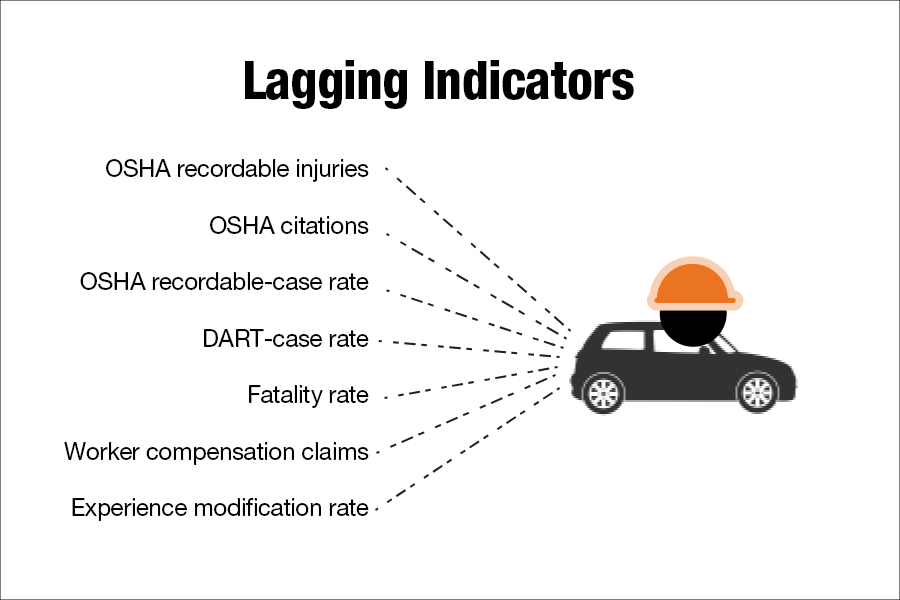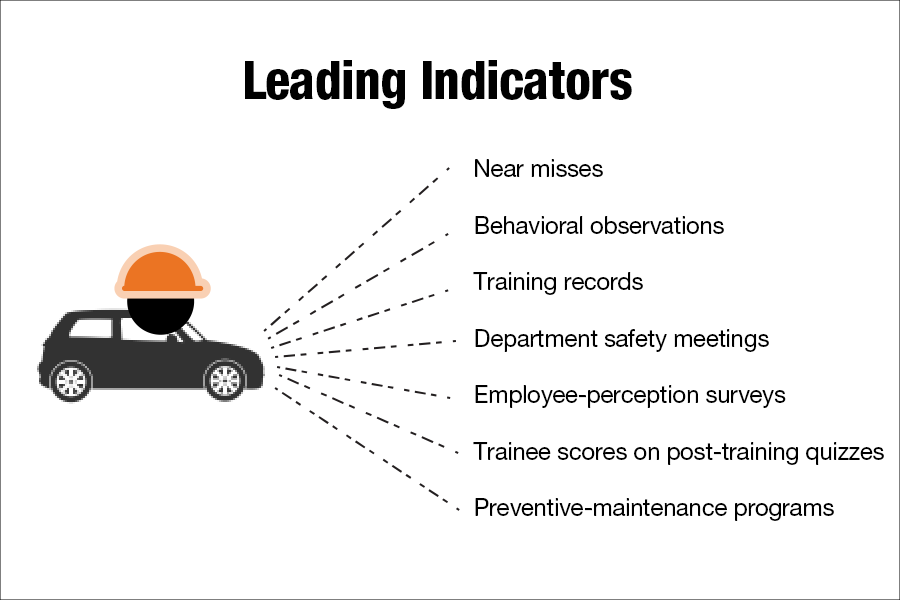Are You Watching the Road or Looking in the Rearview Mirror?


Using Leading and Lagging Indicators to Track Safety Performance
By Grainger Editorial Staff 7/1/19


Legendary coach Pat Riley once said, “Anytime you stop striving to get better, you’re bound to get worse.” And that applies just as much to a safety program as it does to a basketball team. Complacency is your worst enemy. To avoid it, you have to ask yourself introspective questions to see if you're heading in the right direction. Are you using safety performance metrics to drive continual improvement initiatives? How do you gauge the effectiveness of your safety program? What indicators do you use to evaluate the safety initiatives that are in place? And are they truly relevant?
By looking at the appropriate indicators, you can achieve steady improvement in your safety program. But it's hard to know what the right indicators are when there's no single set that will work for everyone. This white paper will explore the benefits and drawbacks of leading and lagging indicators, and also discuss the importance of these indicators when evaluating your organization’s safety performance.
What Is an Indicator?
According to Merriam-Webster, an indicator is “any of a group of statistical values (as level of employment) that taken together give an indication of the health of the economy.” But since we're talking about safety, let’s modify that to “any of a group of statistical values — like Days Away, Restricted and Transfer (DART) or the percentage of compliant conditions — that give an indication of the effectiveness of an organization’s safety program."
Two Types of Indicators: Lagging and Leading
The many indicators that safety professionals use can be divided into two categories: leading indicators and lagging (or trailing) indicators. Lagging indicators are the most familiar. They measure an organization's historical safety performance and are traditionally used to identify variance from established safety goals. When you begin working as a safety professional, these are the first indicators you learn to use. These are also the ones that most senior managers are comfortable with — and in some cases, they may be the only indicators that an organization uses.

One drawback to relying solely on lagging indicators is that they measure only past occurrences or failures. They can identify how many employees were injured on the job, how many days of work were lost or even how many fatalities occurred over a period of time, but they can’t tell the entire story of an organization’s safety culture.
For example, lagging indicators don't identify initiatives that are being put in place to prevent accidents from occurring. They are reactive rather than proactive. And that can foster complacency. Imagine that front-line supervisors saw a low injury rate for their departments while other performance goals were not being met. It would be understandable if they focused their efforts on the unmet performance goals and lost sight of safety planning. Another drawback to lagging indicators is that they provide an incomplete correlation between cause and effect of injuries. Lagging indicators offer evidence when accidents occur, but they don't identify the root causes.
In the same way that OSHA standards represent only the minimum requirements to keep your employees safe, lagging indicators are the minimum tools to determine the condition of your safety program. These indicators have their place, but they're most effective when they complement other more-forward-looking tools: leading indicators.
Leading Indicators
At the Campbell Institute — the National Safety Council center of excellence for environmental, health and safety (EHS) — a panel of industry EHS experts was asked to describe what leading indicators are. This is the definition they developed: “Leading indicators are proactive, preventative and predictive measures that monitor and provide current information about the effective performance, activities and processes of an EHS management system that drive the identification and elimination or control of risks in the workplace that can lead to incidents and injuries.”
In recent decades, leading indicators have become the primary types of safety indicators. To understand why, just think about driving a car. The front windshield is larger than the rearview mirror. In this analogy, leading indicators are like the windshield, and lagging indicators are like the rearview mirror. Both are essential, whether you're driving a car down the highway or driving your organization on its safety journey. But you'll spend more time looking out the windshield to see what's coming — with leading indicators — than looking in your rearview mirror to see where you've been — with lagging indicators. That's why striking that perfect balance between leading and lagging indicators is important.

Selecting the Right Set of Leading Indicators for Your Organization
The set of leading indicators that you monitor should fit your organization. There's no single solution that’s appropriate for everyone. The Campbell Institute panel identified eight important characteristics that leading indicators should have:
- Actionable — metrics that have measurable steps
- Achievable — setting goals that are obtainable
- Meaningful — obtaining information that justifies continued tracking
- Transparent — metrics that are clearly understandable
- Easy to communicate
- Valid — relevant to the organization’s objectives
- Useful — metrics that are beneficial to the organization’s safety goals
- Timely — distributing information that is still relevant to the organization
Watching the Road
By using a combination of lagging and leading indicators, you can effectively monitor your safety performance. Once you select your set of indicators, it's important to track how well it's working and to be flexible if the set needs to be revised. It’s also critical to get buy-in from senior management. By choosing indicators that align with your business goals, you can help improve safety performance throughout your organization. And if performance bonuses and pay structures are tied to leading as well as lagging indicators, it will be easier to achieve continual safety improvement.
Conclusion
No one set of indicators works for every organization. There are many variables at play, including company size, industry and the current safety culture. It would be nice to choose the perfect set on your first try, but in reality, you probably won’t. But don’t worry; all organizations face this challenge. And trial and error is ultimately the only way to identify the mix of leading and lagging indicators that succinctly reflects the philosophy of your organization's senior leaders.
As you experiment, remember to think big but start small. A great starting point is to identify the information you're already collecting to see if it could supply any useful indicators. There’s no need to begin by trying to amass information for every indicator in the book. Start off with a handful to get the program off the ground.
It's challenging to identify which indicators you should use to align your safety program with your organization’s goals. There's no one-size-fits-all answer. But remember that safety is a journey — and as you move forward, you’ll need to pay attention to the road ahead, even as you glance back in your rearview mirror from time to time.
How Do You Talk About Safety Culture?
Grainger is rewriting the conversation in our new white paper, “How We Should Talk About Safety Culture.” This white paper gives safety leaders strategies to make real change.
Sources
Sinelnkov S, Inouye J, Kerper S. Transforming EHS Performance Measurement through Leading Indicators. 2013. http://www.nsc.org/CambpellInstituteandAwardDocuments/WP-Transforming-EHS-through-Leading-Indicators.pdf
Inouye J. Campbell Institute Practical Guide to Leading Indicators: Metrics, Case Studies & Strategies. 2015 http://www.nsc.org/CambpellInstituteandAwardDocuments/WP-PracticalGuidetoLI.pdf
National Safety Council Campbell Institute. Practical Guide to Leading Indicators: Metrics, Case Studies & Strategies Sept. 2014
National Safety Council Campbell Institute. Transforming EHS performance measurement through leading indicators Sept. 2013
The information contained in this article is intended for general information purposes only and is based on information available as of the initial date of publication. No representation is made that the information or references are complete or remain current. This article is not a substitute for review of current applicable government regulations, industry standards, or other standards specific to your business and/or activities and should not be construed as legal advice or opinion. Readers with specific questions should refer to the applicable standards or consult with an attorney.








